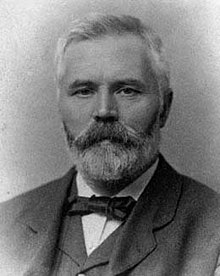| Andrew Gray | |
|---|---|
 | |
| Born | 2 July 1847 (1847-07-02) Lochgelly, Fife, Scotland |
| Died | 10 October 1925 (1925-10-11) (aged 78) |
| Alma mater | Glasgow University (MA 1876, DSc, LLD(Hon) 1896) |
| Known for | "Absolute Measurements in Electricity and Magnetism" (1883) "Treatise on Bessel Functions" (1895) "The Scientific Work of Lord Kelvin" |
| Spouse | Annie Gordon |
| Children | James Gordon Gray |
| Scientific career | |
| Fields | Physics Mathematics |
| Institutions | Private Secretary to Sir William Thomson, Glasgow (1875–80) Secretary to Sir William Thomson, Glasgow University (1880–4) Professor of Physics, University College, Bangor, Wales (1884–99) Professor of Natural Philosophy, Glasgow University (1899–1924) |
Andrew Gray FRS FRSE (2 July 1847 – 10 October 1925) was a Scottish physicist and mathematician.
Life
Born in Lochgelly, Fife, the son of John Gray, he was educated at Lochgelly School and then studied at the University of Glasgow (MA 1876), where he was appointed the Eglinton Fellow in Mathematics in 1876. Perhaps more significantly, however, in 1875 he became the assistant and private secretary of Professor William Thomson (later Lord Kelvin). He held this post – an official University one after 1880 – until 1884, when he was appointed Professor of Physics at the newly founded University College of North Wales.
In 1883 he was elected a Fellow of the Royal Society of Edinburgh. His proposers were Lord Kelvin, James Thomson Bottomley, and John Gray McKendrick. He served as vice-president to the society 1906 to 1909.
In June 1896 he was elected a Fellow of the Royal Society
He remained in Bangor until 1899, when he returned to Glasgow to become the Professor of Natural Philosophy, succeeding Kelvin on his retirement. He held this chair for twenty-four years, stepping down in 1923, shortly before his death.
He lived on campus, his address being 11 University, Glasgow.
Publications
His major scientific publications included works on electromagnetism, dynamics and Bessel functions. He also wrote a treatise on gyrostats.
His FRS candidacy form itemised the following:
- 'Absolute Measurements in Electricity and Magnetism' (1889)
- Theory and practice of absolute measurements in electricity and magnetism. Vol. 1. London: Giacomo Monti. 1893.
- Theory and practice of absolute measurements in electricity and magnetism. Vol. 2. London: Macmillan. 1893.
- 'A Treatise on Magnetism and Electricity'
- 'On the Determination in Absolute Units of the Intensity of Powerful Magnetic Fields' (Phil Mag, 1883)
- 'On the Dynamical Theory of Electro-magnetic Action' (ibid, 1890)
- 'On the Calculation of the Induction Coefficients of Coils' (ibid, 1892)
- 'On a New Reflecting Galvanometer of great sensibility, and on New Forms of Astatic Galvanometers,' jointly with T Gray (Proc Roy Soc, 1884)
- 'On the Relation between the Electrical Qualities and the Chemical Composition of Glass and Allied Substances,' Part I, jointly with T Gray and J J Dobbie (Proc Roy Soc, 1884)
- 1888 Diary of cruise to Australia
- 'On the Electro-magnetic Theory of the Rotation of the Plane of Polarized Light' (Rept Brit Assoc, 1891).
Later works included:
- Treatise on Bessel Functions (1895) with G B Mathews
- Magnetism and Electricity (1898)
- Dynamics and Property of Matter (1901)
- The Scientific Work of Lord Kelvin (1908)
- Dynamics (1911) with his son James Gray
- Treatise on Gyrostatics and Rotational Motion (1919)
Family
He was married to Annie Gordon. Their four sons and four daughters included James Gordon Gray FRSE.
References
- Waterston, Charles D; Macmillan Shearer, A (July 2006). Former Fellows of the Royal Society of Edinburgh 1783–2002: Biographical Index (PDF). Vol. I. Edinburgh: The Royal Society of Edinburgh. ISBN 978-0-902198-84-5. Archived from the original (PDF) on 4 October 2006. Retrieved 27 January 2011.
- ^ Biographical Index of Former Fellows of the Royal Society of Edinburgh 1783–2002 (PDF). The Royal Society of Edinburgh. July 2006. ISBN 0-902-198-84-X. Archived from the original (PDF) on 24 January 2013. Retrieved 31 July 2016.
- "Library and Archive Catalogue". Royal Society. Retrieved 9 November 2010.
- Glasgow Post Office Directory 1911–12
- Andrew Gray, Absolute Measurements in Electricity and Magnetism, MacMillan and Co., London (1884) .
- Wilson, Edwin Bidwell (1902). "Review: A Treatise on Physics, Vol. 1, Dynamics and Properties of Matter, by Andrew Gray". Bull. Amer. Math. Soc. 8 (9): 403–412. doi:10.1090/s0002-9904-1902-00922-1.
- Bôcher, Maxime (1896). "Review: A Treatise on Bessel Functions and their Applications to Physics, by Andrew Gray and G. B. Mathews". Bull. Amer. Math. Soc. 2 (8): 255–265. doi:10.1090/s0002-9904-1896-00343-8.
- A. Gray, 1959: A Treatise on Gyrostatics and Rotational Motion: Theory and Applications (Dover, New York). Originally published in 1918 by Glasgow University Press.
- "Andrew Gray - Biography". Maths History.
- GRAY, Andrew (b. Scotland, 1847 – d. 10 October 1925). (2005). In Who Was Who 1897–2005.
External links
- Works by Andrew Gray at Project Gutenberg
- Works by or about Andrew Gray at the Internet Archive
- O'Connor, John J.; Robertson, Edmund F., "Andrew Gray", MacTutor History of Mathematics Archive, University of St Andrews
- 1847 births
- 1925 deaths
- People from Lochgelly
- Academics of the University of Glasgow
- Academics of Bangor University
- Alumni of the University of Glasgow
- Scottish mathematicians
- Scottish physicists
- Fellows of the Royal Society
- Fellows of the Royal Society of Edinburgh
- Scottish biographers
- Mathematical physicists